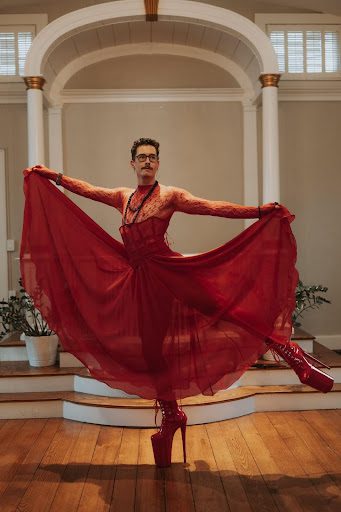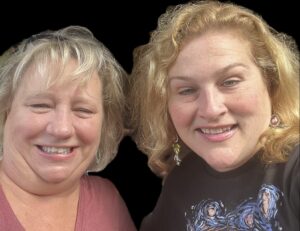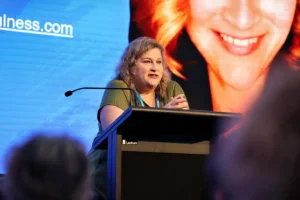When I was in sixth grade, my cousin and I went to a Lady Gaga concert in Detroit. It was, in many ways, a queer awakening (though I wouldn’t have used those words then).
I remember feeling something in the room before the music even started. The bass was loud, the crowd was strange and beautiful and buzzing with a kind of aliveness I had never been around before. Something in me stirred, something that had been quiet for a long time. I couldn’t name it, but I felt it: I belonged. For a moment, that familiar whisper inside (the one that always said I didn’t quite fit in) went silent.
Then she came out on stage, in towering stilettos. And I wanted to wear them. I didn’t just admire them. I wanted them on my feet. And that terrified me.
As a skinny white Catholic boy from rural Ohio, I had no context for that feeling. I knew it wasn’t something I was supposed to want. So I did what so many of us do: I pushed it down. To stay safe. To stay loved. To make sure nobody kicked my ass on the way home from school.
Apart from a few (or many) quiet nights lip-syncing in front of my bedroom mirror, and a long stretch of admiring drag queens from the edge of dance floors in my twenties, that part of me stayed hidden.
Until last year.
In 2024, I took a workshop called The Soul of Dissociation with Amy Wagner through the Institute for Creative Mindfulness. It was meant to help clinicians better understand and support clients who navigate dissociative experiences, but it also encouraged us to turn inward and explore our own parts. I had already done some of that work in therapy, and I’d read No Bad Parts by Richard Schwartz, but what emerged during that workshop surprised me.
We were asked to create a map of our internal system. When I put pen to paper, a vivid image came through. It wasn’t abstract. It felt like a real inner landscape I’d been living in but had never seen clearly until that moment.
What struck me most was how naturally this map blended what I’d learned in different traditions and modalities like parts work, EMDR, yoga, meditation, iRest, even elements of Advaita Vedanta and Kashmir Shaivism. Theoretical ideas about the Self and systems suddenly became something I could see. It felt cohesive in a way that my inner life had been trying to become for years.
There was one part of the map I kept coming back to: a boundary, soft but solid, separating the side of me I show the world (the sun side) from the side I keep more private (the moon). And there, resting quietly in the moonlight, was a stiletto.
(note: some parts desired to remain private for this blog)
When I showed the map to my therapist, he pointed to that part and said, “I think that stiletto holds a lot of power you don’t have access to yet.”
And I knew he was right.
But I also knew that part had been protected for a reason.
Not long after that, I took a course with Dr. Jamie Marich on self-disclosure. It changed the way I thought about what it means to show up as a therapist and teacher. So much of my training emphasized neutrality: being a blank slate, disappearing into the background so clients or students could project what they needed. But what this course offered was something different – that allowing ourselves to be seen, when done skillfully and ethically, can be a meaningful part of healing. That connection itself can be the medicine.
That idea stayed with me.
So I started sitting with the part of me that wanted those heels. I didn’t try to change her or interpret her. I just listened. I noticed how she felt in my body (low in my belly, like a warm shimmer) and I asked what she wanted.

Her first request: buy the heels.
So I did. It felt like this.
Then she asked me to learn to walk in them. That took a little longer and came with some minor bruising and mild plantar fasciitis. But eventually, I did!
Then she said: teach a class in them. And post a picture so everyone in your life can see.
Yikes! That’s when the protective part showed up. I could feel his tension, his fear. I saw him like a closet door, worn but strong. We talked. I thanked him for all the ways he had kept me safe, all the times he stepped in so I could fit in. And then I asked him what he wanted.
What surprised me is that what he wanted wasn’t silence or hiding. It was freedom. He wanted it to be safe enough for me to be myself.
And when we saw that together, the door opened. Something exiled in me (something that hadn’t fully breathed since sixth grade) finally got to step forward.
Everything shifted after that.
That part of me, the one in the heels, is bold, yes, but also kind. She’s expressive. She’s clear. She’s not performing. She’s not trying to be provocative. She just is. And she doesn’t care what people think the way I often do.
When I posted the photo online, I braced myself for criticism. But it didn’t come. People were incredibly kind. Not one negative remark – ever (though that would have been welcome, too). What I came to realize is that their range of reactions – from fascination to indifference and everything in between – had almost nothing to do with me. They were reflections of their own relationship to self-expression and truth. What I had most feared being seen for became the doorway to recognizing my own sovereignty.
And when I finally taught the class in those heels, I could feel it in the room. Something was different.
At the end of class, during our reflection time, people began to share more than I’d expected. One person read a poem they wrote about fear and longing. Another spoke about their own desire to be more visible. A few people shared truths – diagnoses, identities – they hadn’t ever said out loud in public before. Something about the space felt safe enough for that. Honest enough.
And it taught me this: healing doesn’t happen when we vanish. It happens when we’re here. It asks us to show up. Not loudly or perfectly, but fully.
Whether we’re therapists, teachers, healers, or humans, what gives others permission isn’t our polish. It’s our presence. When we do the work to meet and integrate our own parts, something in us radiates that safety outward. Even if we don’t say a word.
So, if you’ve made it this far, I’ll leave you with a version of the question I’ve been sitting with myself. Take a second. Pause. Let it steep:
What is your ten-inch heel?




